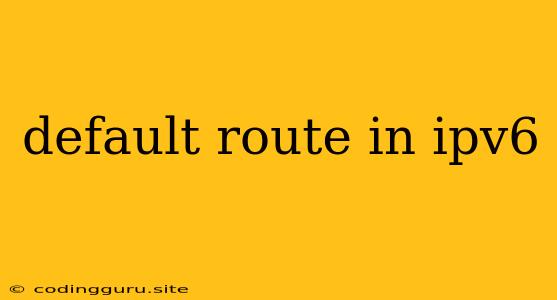What is a Default Route in IPv6?
In the vast world of computer networking, IPv6, the latest version of the Internet Protocol, is the cornerstone of internet communication. A fundamental concept within IPv6 is the default route, which acts as a guiding light for network traffic when its destination is unknown.
Imagine your computer as a traveler on a grand network map. It needs to know where to send its packets, just like you need to know how to get to your destination. The default route is like a GPS system; it tells your computer, "If you don't know where to go, send the packet to this specific gateway."
Why Do We Need a Default Route?
Let's explore the critical role a default route plays in the intricate world of IPv6:
- Connecting to the Wider Internet: When your computer needs to reach a destination outside your local network, the default route points it towards a gateway (usually your router) that connects to the global internet.
- Handling Unknown Destinations: If a packet is destined for a network your computer doesn't have an explicit route to, the default route ensures it is sent to the right gateway for processing.
How to Configure a Default Route in IPv6
Configuring a default route in IPv6 is essential for proper network connectivity. Here's a breakdown of the common methods:
1. Using the route command (Linux/macOS):
sudo route -A inet6 add default gw
- Replace
<gateway_ipv6_address>with the IPv6 address of your router. - The
-A inet6option specifies that the command applies to IPv6 routes. defaultindicates that this is a default route, used when no other matching route is found.gwspecifies the gateway address.
2. Using the ip command (Linux):
sudo ip -6 route add default via
- This command is similar to the
routecommand but offers more flexibility for route manipulation.
3. Using the Network Control Panel (Windows):
- Open the Network and Sharing Center.
- Click on the Change adapter settings link.
- Right-click on your network adapter and select Properties.
- In the Networking tab, find the Internet Protocol Version 6 (TCP/IPv6) entry.
- Click on the Properties button.
- Check the box for Use the following IPv6 address.
- Enter your IPv6 address, subnet mask, and default gateway address.
Finding the Default Gateway's IPv6 Address
To configure your default route, you'll need the IPv6 address of your gateway. Here's how you can find it:
1. Using the ip command (Linux):
ip -6 route get
- Replace
<any_ipv6_address>with any valid IPv6 address. - The output will show you the default gateway address used for that destination.
2. Checking Your Router's Configuration:
- Access your router's configuration panel (usually accessible through a web interface).
- Look for the IPv6 settings, which will often show your router's IPv6 address (which serves as the default gateway).
Troubleshooting Default Route Issues
If your computer is not connecting to the internet correctly, a problem with your default route might be the culprit. Here are some common issues:
- Incorrect Gateway Address: Double-check that the gateway address you configured is accurate.
- Firewall Blocking: Your firewall might be blocking the default route. Review your firewall rules and ensure they don't interfere with IPv6 traffic.
- Duplicate Routes: Multiple default routes might conflict with each other. Ensure you have only one configured.
Importance of the Default Route
The default route is a crucial component of IPv6 networking. Without a properly configured default route, your computer wouldn't know where to send network traffic beyond your local network, resulting in connectivity issues.
Conclusion
Understanding the default route is fundamental for anyone working with IPv6 networks. It provides the essential guidance for traffic destined outside your local network. By configuring and troubleshooting your default route effectively, you can ensure smooth and reliable network connectivity in the ever-expanding world of IPv6.
